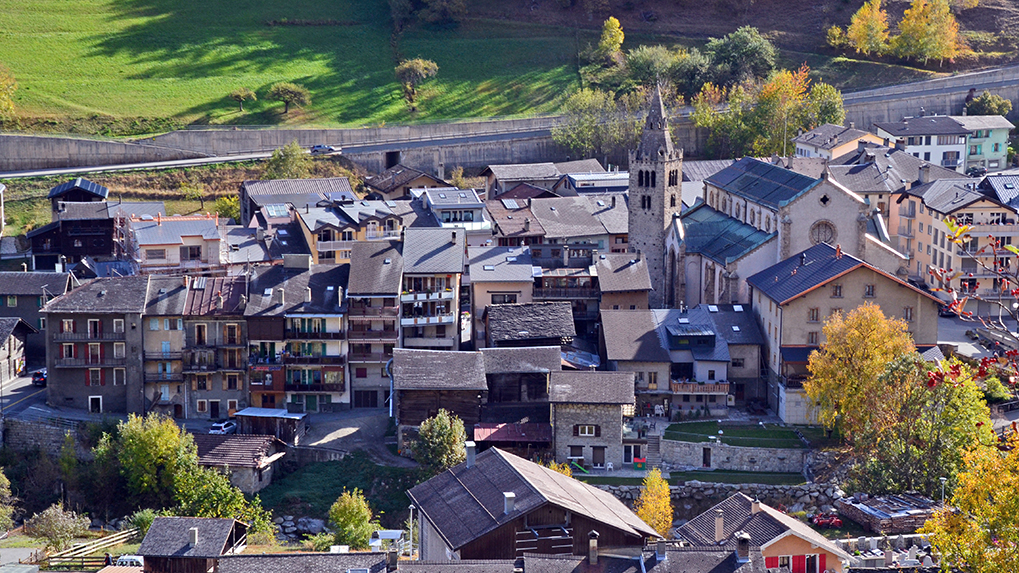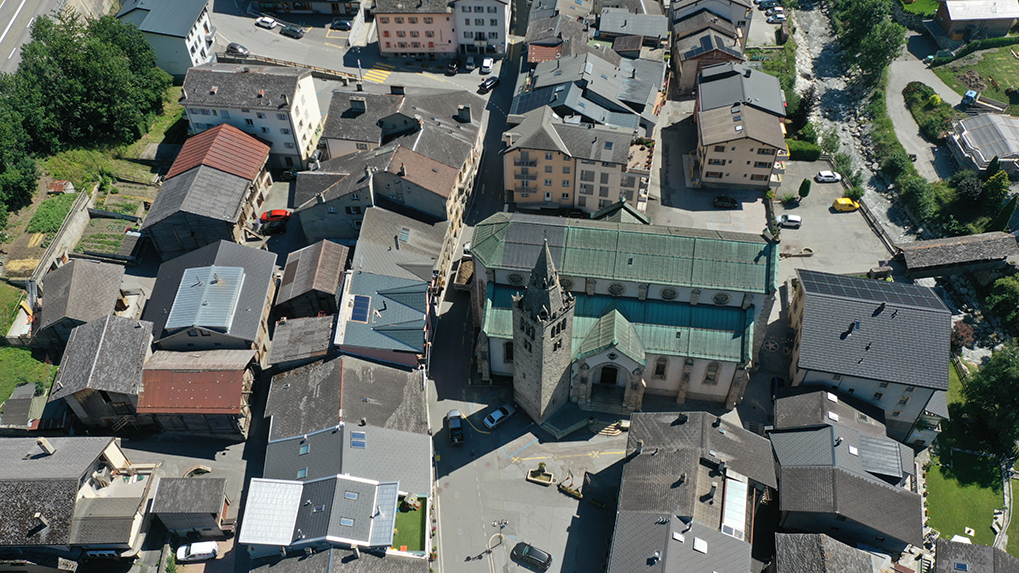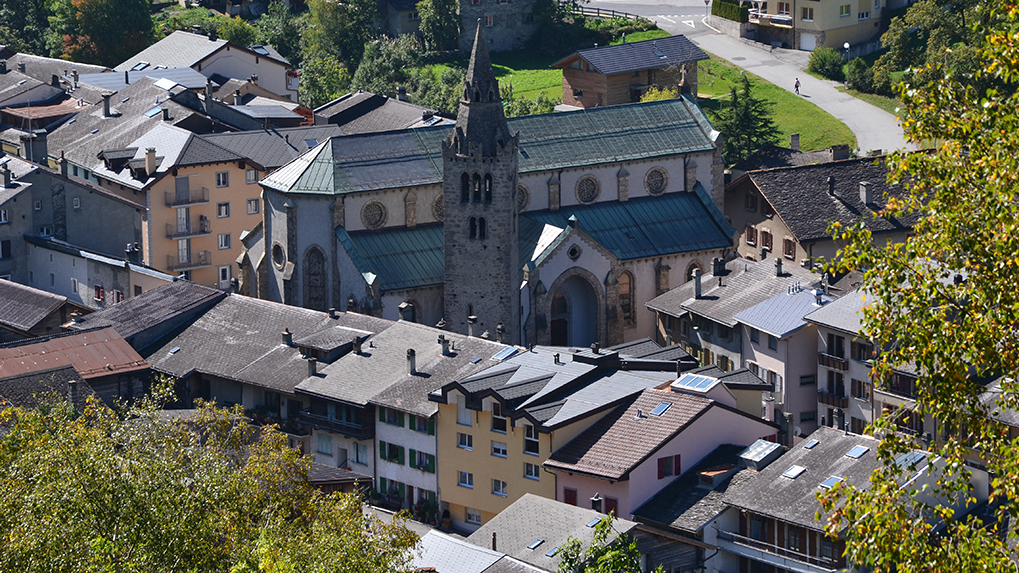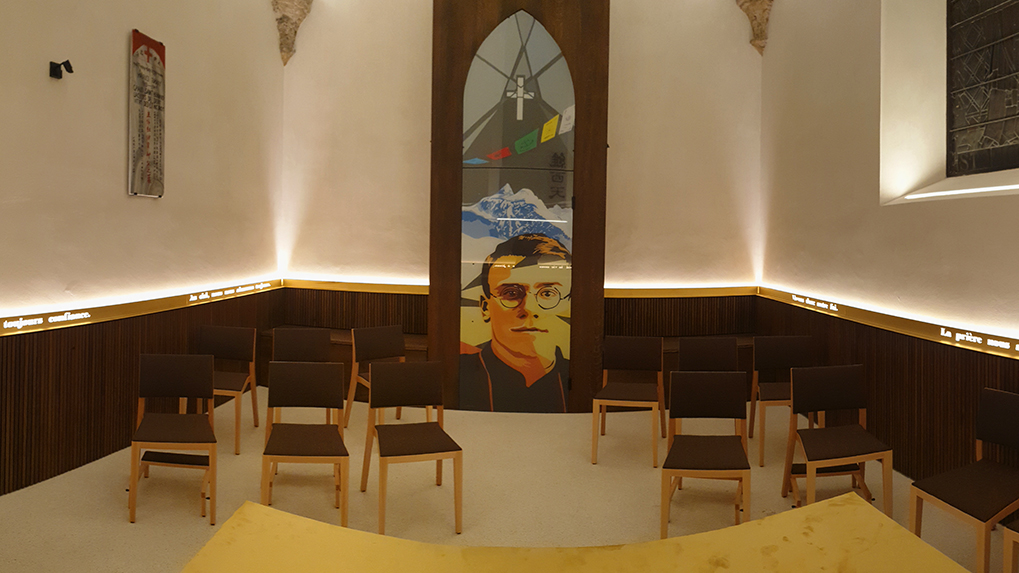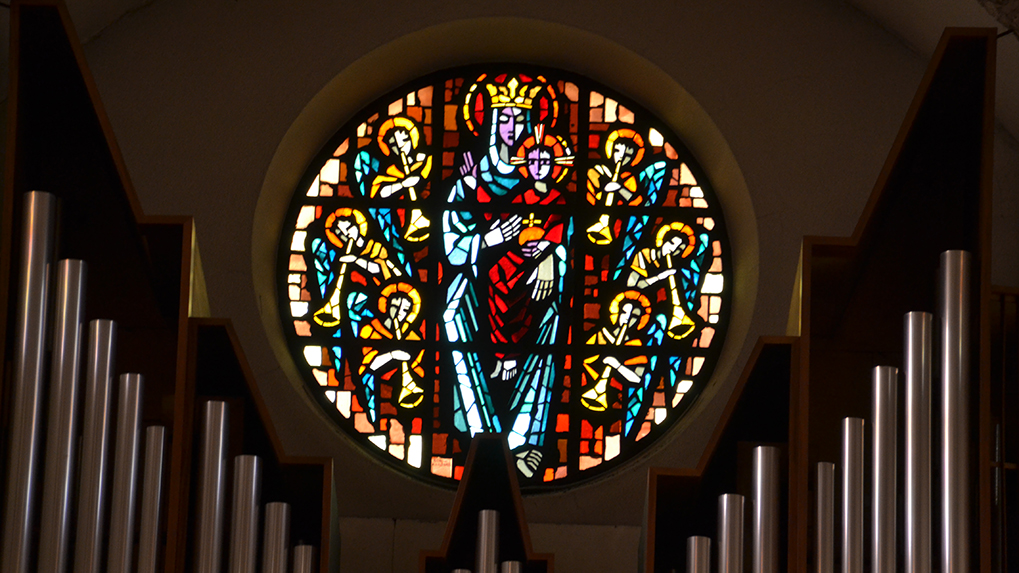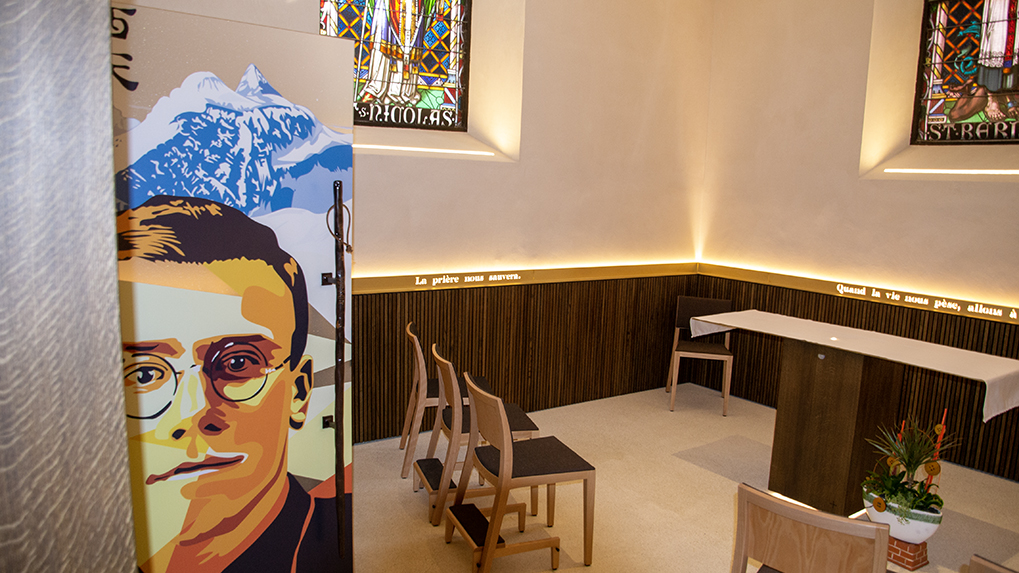The church was built on its present site, in the centre of the commune, in what was probably in the Middle Ages a fortified village. Over the centuries, it has undergone profound architectural changes, demolitions, extensions, transformations, destructions and improvements until 1996.
The information below is partly extracted from a pilot project carried out in 2019, co-financed by the Canton (New Regional Policy), the HEP, the HES-SO Valais and the communes of Orsières and Evolène, called “Classes en action”. The project highlights the work of classes on a heritage theme and aims to make children aware of the importance of heritage and culture so that they can become the best cultural ambassadors.
The Early Church
According to some researchers, Orsières may have had an early sanctuary between 850 and 950, but its position is not yet certain.
The Romanesque church
The first Romanesque church was built on the east side of the bell tower, facing Jerusalem, and outside was the village cemetery. The position of the church was very peculiar in relation to the fabric of the village, which developed to the north. It was modest in size and was dedicated to Saints Pantaleon and Blaise. This information comes from a papal bull of the popes Gregory IX and Nicholas III.
In the papal bull of Honorius IV of 1286, it is stated that the church has been dedicated to Saint Nicholas since 1278.
We do not know how it was decorated inside, but it had a number of tombstones. The most interesting part is the bell tower with round arches. Its plan measures 5m15 by 5m10 with three sets of ogival arches on each side and a stone spire above. Animal sculptures in the form of gargoyles decorate the southern façade.
In 1497, a new, larger church with wooden vaults was consecrated. The old sanctuary was demolished, with the exception of the semicircular choir, which became a side chapel, and possibly part of the north aisle, which served as a corridor to the bell tower.
Inside the church several altars are dedicated to saints, including St James, and equipped with the relics of St Theodule and St Catherine. In 1499, an altar was dedicated to Saint Michael and in 1545 to Saint Eusebius.
The third church
In 1896 a new, larger building was constructed for safety reasons, the old one being too small to accommodate the entire population.
To achieve this, many requests were made, the first by Bishop Roten, but in the end it took more than 30 years to build it. During the visit of Monseigneur de Preux in 1862, the request to build a new church was renewed, but it was not until 1865 that an authorisation was signed, on the initiative of the Vicar Jean-Pierre Lovay.
After various vicissitudes, the church was built around 1896. It is 35 metres long and 20 metres wide.
The church is in the late Gothic style with three naves and a granite foundation. The ceiling ribs are ochre-coloured and made of tuff. They were created by the architect Joseph de Kalbermatten from Sion. The baptistery and the pulpit have been classified as historical monuments.
The clock in the bell tower was installed in 1893 and cost 1400 francs.
The cemetery was moved across the river in 1869.
Restoration of the building after 100 years
On the evening of 6 January 1958 a fire broke out in the choir of the church. A commission was set up to restore the building and Pierre Fever was appointed to manage the work. The work lasted until 1962 and changed the interior of the church considerably.
In 1996, on the occasion of the church’s centenary, further work was undertaken, such as the creation of steps to the sacristy and the construction of the external ramp for the disabled.
The façade
Looking at the main façade, one can see the Romanesque style, it is divided into three and each corresponds to three vessels.
The entrance portal on the sides is made of tuff with a pointed arch. Above the portal there is a mosaic by Paul Monnier. In the façade there is a large central rose window above which there is a small cross. On the sides you can see the buttresses.
The bell tower
The bell tower has been defined as one of the most beautiful monuments in the whole of the Valais, built in the Romanesque style and probably in the 14th century. The oldest part is the first floor, where there is a semicircular arch. The bell tower houses six bells on three different levels.
The highest ones were placed in 1813 and dedicated to St. Maria Luisa and St. Napoleon. On the middle level, there are those dedicated to Saint Nicholas and Saint Ursula dated 1727 and recast in 1883. The oldest dates from 1732 and is dedicated to the Virgin Mary. On the ground floor of the bell tower there is a surprisingly well-preserved room. This level is completely separate from the rest of the bell tower and is accessible from the choir of the first church. In the past it probably served as a sacristy or small chapel.
This could explain, according to historians, the presence of an exterior niche called “The Mass of Saint Gregory”, a very special and unusual fresco made around the 15th century.
The Mass of Saint Gregory
Pope Gregory I was also called “the Great”, which meant saint. Among the legendary episodes of his life, the “Mass of St. Gregory” is particularly famous. The scene tells of the moment of the Eucharistic consecration of St Gregory the Great (540-604) on Christmas Day in the Roman Basilica of the Holy Cross in Jerusalem.
The miraculous event is the appearance of Christ to the pope, with the stigmata from which the blood flows, which is collected in a chalice. This episode, it seems, according to various versions, occurred when one of the people present at the Mass doubted, and according to others, the Pope himself, about transubstantiation.
The fresco is divided into two scenes: on the left, Saint Gregory presents the host assisted by two little deacons; above, a flying angel holding the papal tiaras above his head; on the right, the Christ of piety with his head bowed and hands crossed, represented in a half bust [La messe de Saint Grégoire du clocher d’Orsières G. Cassina].
The representation of the dead body of Christ was formed in the Byzantine world from the definition of the Humiliation Sumo and in the West, with the Christ of Pity or “Imago Pietais”. This iconography became particularly topical in the 15th century. The image of Christ emerging from the tomb is sometimes flanked by angels.
“The arms of Christ were represented in different ways, crossed in front of the body, to imitate the way corpses were laid in the tomb, or open and wide, or in the gesture of the “ostentatio vulnerum”, or with the right hand on the side wound…”[Gallori 2011, pp. 20-21, note 5].
The organ
It was first built in 1916 by Carl Männedorf. In 1962 a new organ was built by Kuhn AG, Männedorf.
The pulpit
In the old church, the pulpit was located on the south wall. In 1896 it was moved to the north and attached to a column in front of the choir. It consists of a statue of Samson holding a basin. Samson is shown with one knee on the ground, the other bent, and his hands raised on either side of his head to support the weight of the laver. This statue, carved from a walnut trunk, has never been painted. The basin is decorated on each side, framed by small columns and winged cherubs. It seems to date from the years 1735-1740. The sculptor Jean-Baptiste Bozzo, who was present in Orsières in those years, could be the author.
The baptismal font (1691)
The octagonal stone basin has a carved walnut cover. Its cover is made of carved walnut. The main body is decorated with fruit, angels’ heads and foliage. Above, an aedicule composed of eight arches houses the statues of Saint John the Baptist and Christ. The crown surmounted by a globe and a cross recalls a domed roof.
Saint Nicholas
St Nicholas is a popular figure in Christian hagiography. He has been canonised and proclaimed protector of many nations. He was probably born in Pàtara di Licia, in Asia Minor, now Turkey, between 260 and 280.
Born into a noble Christian family, he was elected bishop for his gifts of piety and charity, which were well known from his childhood.
His fame is universal, documented by churches and works of art, institutions and traditions linked to his name. There is very little information about his life. According to some legends, he performed one miracle after another, for example miraculously rescuing three officers from torture or saving Myra from famine. He also calmed a storm at sea and resurrected three children.
Nicholas died on 6 December, probably in the year 343, in the monastery of St. Zion near Myra, and even then he was said to work miracles. This belief spread after his death, thanks to the many legends that spread in the East. His remains were preserved until 1087 in the cathedral of Myra in Turkey. The cult of St Nicholas has spread throughout the world.
In the Russian Orthodox Church, St. Nicholas is depicted in churches as the third icon, together with Christ and Mary with the Child.
In New York, he spread thanks to the Dutch settlers (he is in fact the protector of the city of Amsterdam), under the name of ‘Sinterklaas’, Santa Claus (short for Sanctus Nicolaus)
St. Nicholas depicted with the 3 children
According to one version, this happened on Nicholas’ way to the Council of Nicaea. He stopped at a tavern and was presented with a plate of fish, or so the innkeeper said. Nicholas, divinely inspired, noticed that it was human flesh instead. Calling the innkeeper, he expressed a desire to see how this “fish” was preserved. The innkeeper accompanied him to two small barrels filled with the salted meat of the three children he had killed. Nicholas then began to pray and the flesh of the three children was recomposed, the children jumping happily out of the barrels. Nicholas’ prayer led the innkeeper to conversion, even though he had initially tried to hide his misdeed.
The second version of the legend does not mention children, but pupils. A nobleman from a village near Myra who had to send his children to Athens to continue their studies told them to go to Myra to seek the blessing of Bishop Nicholas. As the latter was absent, they were unable to meet him and, when evening came, they sought an inn. Seeing them rich, the innkeeper entered their room at night and killed them, taking their precious clothes.
Not satisfied, he mixed their flesh with other salted meats, to give to the guests. (Vita di San Nicola di P. Gerardo Cioffari)
The next day, Nicholas, divinely warned, went to the innkeeper to ask him about the meat he was serving to his customers. The innkeeper showed him the meat he had saved, adding that it was good to eat. The Saint blessed the meat and the three students came back to life. Through prayer, the innkeeper repented and promised to lead a virtuous life. The three students, as if awakening from their sleep, took their things and resumed their journey to Athens.
Saint Nicholas and the three little bags
Saint Nicholas is often depicted in various paintings with three little bags. According to the legend, Nicholas saves girls. The texts say that a father had daughters of marriageable age and seeing that his daughters were marginalised because the family had fallen into extreme poverty, he wanted to do something desperate.
Nicholas was aware of this family tragedy and decided to intervene in the way suggested in the Gospel: “When you give alms, do not play the trumpet in front of you, as the hypocrites do in the squares, to be honoured by men. When you give alms, do not let your left hand know what your right hand is doing, so that your alms may remain secret, and your Father who sees in secret will reward you” (Matthew, VI, 2-4). St. Nicholas, acting prudently, collected a sufficient quantity of gold coins in a cloth, threw it secretly out of the window into the man’s house, and quickly returned home. The next day, the man got out of bed, found the bundle of money in the middle of the house and weeping with joy, amazed and astonished, he gave thanks to God.
The stained glass windows of the church of St. Nicholas
The church of St. Nicholas has numerous stained glass windows, some of which are in the neo-Gothic style.
In 1896, the architect Joseph de Kalbermatten, who was called upon to restore the church, asked glass painters from Fribourg, Kirsch and Fleckner (gold medals in 1900 at the Universal Exhibition in Paris) to create new stained glass windows for the church. The artists created two stained glass windows in the choir, one dedicated to “Saint Nicolas de Myre” and the other to Saint Bernard. The figures are depicted in a window with infill, topped by a neo-Gothic decoration. The windows are grisaille.
Grisaille is the painting technique used in ancient medieval stained glass. The glass is opaque and lightly coloured, using a different technique from that of stained glass. The tesserae of blown glass that make up the glass are painted by hand with metallic oxides and then fired in a kiln at temperatures of about 650°C. In 1918, a banker, Alfred Tissières, commissioned stained glass windows for the church in Orsières, made by Ernest Biéler and François de Ribaupierre (1919). The window illustrates three episodes from the life of Saint Jerome.
Between 1958 and 1962, the church in Orsières underwent numerous restorations, including the restoration of the stained glass windows by the Valaisan artist Paul Monnier (1907 Montana-Vermala – 1982 Carouge), in two stages, the first of which consisted of redoing the stained glass windows in the choir, where the new windows were placed with Saint Nicolas de Myre (Miracle of the Three Children) and Saint Bernard.
He used glass slabs set in a concrete lattice.
The new chapel of Blessed Maurice Tornay (2021)
At the top of the church in Orsières, on the left, a magnificent new chapel dedicated to Blessed Maurice Tornay was inaugurated on Sunday 12 September 2021 in the presence of Monsignor Jean-Marie Lovey, Bishop of Sion.
Luminosity, beauty, clean lines in harmony with the limited surface area, and a warm atmosphere conducive to meditation have found their place in this modern chapel decorated with quotations from the Blessed.
The whole is also magnificently enhanced by the stained glass windows representing Saint Nicholas, patron saint of the parish, and Saint Bernard, patron saint of mountain people.
The chosen project follows a broad call for projects from several architectural offices. It meets the architectural requirements of the site. The interior atmosphere is reminiscent of the language and style of the church. Thanks to subtle lighting, the atmosphere is warm and there is no clash with the main church.
The space dedicated to Blessed Maurice Tornay (2021)
Entering through the door on the west side (cure), you will discover a series of paintings showing the different stages of the Blessed’s life:
1910 – 1025: Child of the Rosary
1925 – 1031: Student at the college of Saint-Maurice
1931-1935: Canon at the Grand-St-Bernard
1936-1945: Misionary in the Tibetan Marches
1938: Priest for the Church
1945-1946: Parish priest in Yerkalo
1946-1949: Martyr in Tibet
Opening hours: Same as the church, approximately 7am – 8pm.
Enjoy your visit.
Accessibility

